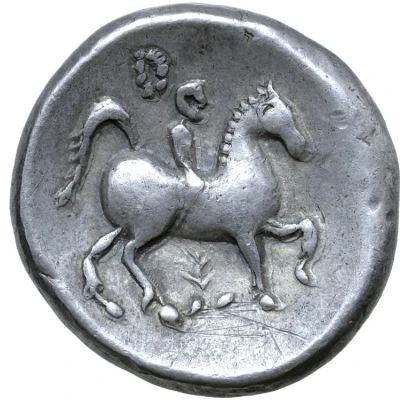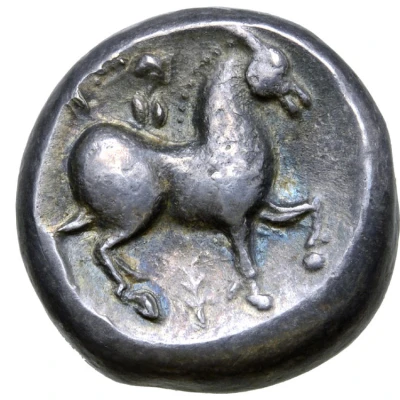


© Roma Numismatics Limited
Tetradrachm Apollokopf-Dickschrötling Type 300 BC - 201 BC
| Silver | 12.84 g | 20 mm |
| Issuer | Uncertain Eastern European Celts (Uncertain Central and Eastern European Celts) |
|---|---|
| Type | Standard circulation coin |
| Years | 300 BC - 201 BC |
| Value | Tetradrachm (4) |
| Currency | Drachm |
| Composition | Silver |
| Weight | 12.84 g |
| Diameter | 20 mm |
| Shape | Round (irregular) |
| Technique | Hammered |
| Orientation | Variable alignment ↺ |
| Demonetized | Yes |
| Updated | 2024-10-09 |
| Numista | N#193877 |
|---|---|
| Rarity index | 100% |
Reverse
Stylised rider on horseback to right; wreath above, branch below.
Comment
Göbl, OTA pl. 18, 226/3 or 227/2 (obverse) and 227/1 (reverse same die);Examples of this type:
• Example #1 (12.12g, 25mm, 11h, Near Very Fine) - in main image:
◦ Ex-Hermann Lanz Collection; published in Michaela Kostial - "Kelten im Osten. Gold und Silber der Kelten in Mittel und Osteuropa, Sammlung Lanz", München, 1997, #527;
◦ Exhibited by the Staatlichen Münzsammlung München at the 1997 International Numismatic Congress in Berlin; at the Berliner Bank also in 1997; also exhibited at the Luitpoldblock Palmengarten, Munich in 2003 (exhibition #94[reverse]);
◦ Auctioned by Roma Numismatics Ltd, Auction XVII, 28 March 2019, Lot 135. Sold for 340 GBP.$
◦ Auctioned by Schulten & Co., Auction 12, 2 November 1983, lot 3.
Interesting fact
One interesting fact about this coin is that it features an image of Apollo on one side and a celestial body, possibly a moon or a star, on the other. This suggests that the Celts who created this coin may have had a strong connection to the gods and the night sky. Additionally, the fact that it was made of silver suggests that it was a valuable and highly sought-after coin in its time.



